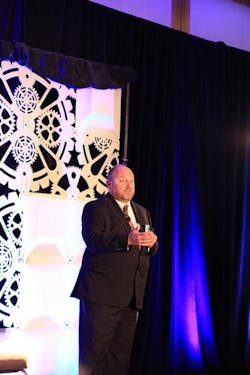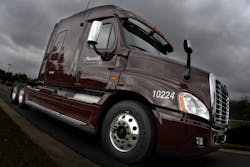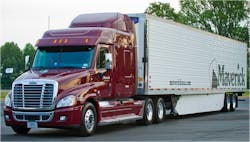Yet it’s also why Curt Valkovic, director of driver training for Maverick Transportation out of Little Rock, AR, is very blunt about why the industry needs to completely overhaul how it hires, trains, and retains truck drivers.
“The number one reason for turnover in our company is the lifestyle,” he explained during a presentation at the 2015 ALK Transportation Technology Summit in Princeton, NJ, this week.
“Family issues are why most of them leave; it is so very hard on their families,” Valkovic (seen at right) said. “But we don’t get frustrated when they tell us that. I tell my team to hug them, to let them know we care about them. We get emotional because we know how hard it is.”
Valkovic speaks from experience, too. A long haul driver himself for nearly 20 years before joining Maverick in 2000 and then taking the reins of its driver training operation, he told the audience that his now 28 year old daughter largely grew up without him due to the demands of the freight world.
“I just wasn’t there,” Valkovic said. “Today I have a two year old grandson and he knows how to use Face Time to talk with me. That’s one reason why IT [information technology] is so important in our industry today. It helps a driver stay connected to the family.”
He added that’s also why Maverick now places great emphasis on involving the family in every step of its driver recruitment and training process.
“If the family is satisfied, the driver will be satisfied,” Valkovic said. “If we keep the driver’s family happy, the driver will be happy. That’s what helps us keep the right people behind the wheel.”
Yet he’s also pretty blunt about how difficult it is to find and keep the “right” people driving trucks these days. For example, he noted that Maverick spends roughly anywhere from $8,000 to $10,000 to hire and train a driver candidate. But that occurs after an initial “lead pool” of some 50,000 gets winnowed down to “classes” of recruits.Altogether in 2014, Valkovic said Maverick recruited 1,170 brand new students out of which only 247 finished their training successfully to become full-fledged drivers – just 21% of the student pool and 2% of the 50,000 leads Maverick culled through to begin the process.
On top of that, he pointed out that Maverick’s turnover rate hovers around 61.7% – excellent for the TL segment, where turnover typically hits 100% to 105%, but not even close to the level Maverick would like it to be.
“It used to keep me up at night, but not anymore, because I know my team of 18 instructors – some of the best people I’ve ever been blessed to work with – and I give 110% of our best effort every day,” he said. “It’s all you can do.”
Valkovic said part of the challenge today with new recruits is that most simply aren’t raised anywhere within hailing distance of a truck anymore. Back when he joined Maverick, for instance, he just needed to figure out its paperwork particulars – and he did that largely on his own.
“Today, however, you need an agenda: you need to tell that new recruit what is going to happen and how it is going to happen every step of the way,” Valkovic explained.
No longer are new recruits taught in big classes, either; rather, they are given what he calls “targeted coaching” tailored to their individual needs.
“We don’t look at a ‘class’ of recruits anymore; we look at each individual and focus on the ones who are struggling,” he said.
Real-time assessments track students through the training process, and they are not allowed to move forward until each step is successfully completed – whether that step entails map reading, calculating hours of service (HOS), whatever.“We get what I like to call ‘granular’ on the data, with our instructors monitoring recruit training on sometimes an hourly basis,” Valkovic noted. “If they struggle at any point, we start what we call a ‘driver action plan’ or DAP to help them – which usually adds one or two extra weeks to the training process. It’s all about education to us: What is this individual lacking? And what can we give them to help them succeed?”
The biggest “Achilles heel” for new students these days, he says, is truck management skills – how to most effectively manage the time needed to load and unload freight, conduct pre- and post-trip inspections, keep HOS records up to date, etc.
Yet he also stressed that Maverick’s instructors take several extra steps as well, looking closely at other education-related issues affecting student performance.
“Maybe they don’t take notes well; so we’ll add note-taking training to help them,” Valkovic said. “We actually once discovered three of our recruits – all in their mid-20s – suffered from dyslexia, and they didn’t even know it. So we developed specific DAPs to help them out.”Maverick can provide such “granular” oversight, he pointed out, because the carrier's instructor-to-student ratio is not allowed to exceed 1-to-20.
The carrier also relies on an electronically-based training program called LMS 2.0 developed four years ago that creates what Valkovic called “digital folders” recording every step in a student’s training process.
“Not only does that save us a lot of time not having to deal with paperwork – about eight hours per week for our entire instructor team – it allows us to document our training precisely to show we’re never negligent in our hiring practices,” he emphasized.
At the end of the day, it’s this kind of detailed focus Valkovic feels the trucking industry needs to adopt to help solve its chronic driver shortage and turnover issues.
“Our culture at Maverick demands we put the right person behind the wheel of our trucks,” he added. “We live and die by this every single day.”







